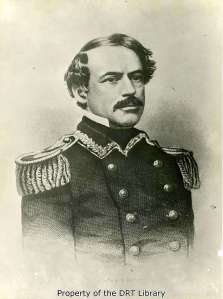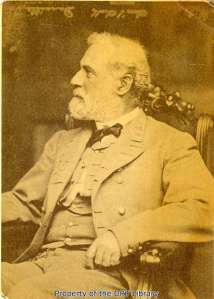Robert E. Lee in Texas
Many people identify Robert E. Lee – who died on October 12, 1870, in Lexington, Virginia – as the Southern commander of the Army of Northern Virginia during the Civil War (1861-1865). However, few may know that his career with the United States military lasted for thirty years, beginning with his graduation from West Point in 1831 and ending when he resigned his commission in the Army to join Virginia and the Confederacy in 1861.

A. H. Ritchie's 1861 engraving of Lee. This image is based upon Mathew Brady's photograph of Lee wearing civilian clothes, taken in the early 1850s. The DRT Library's copy is from the National Archives Photographic Records Office. (SC9958)
Lee’s lengthy career took him to posts across the country. On three occasions, his work also took him to Texas. Lee’s first experience in the Lone Star State occurred during the Mexican War, when he arrived in San Antonio in September 1846 and worked to construct and improve roads, bridges, and pontoons used by General John E. Wool’s army as it marched to Saltillo. Lee returned to Texas between March 1856 and October 1857, when he served with the Second Cavalry as it patrolled the state’s border and protected citizens from Indian attacks. After a lengthy return to Virginia, Lee returned to Texas in February 1860 as the acting commander of the Department of Texas, temporarily replacing an ailing General David E. Twiggs. Part of his duty involved pursuing Juan N. Cortina and stopping his border raids.
The approaching Civil War brought Lee’s time in Texas to an end. Less than three weeks after Texas seceded from the Union on February 1, 1861, General Twiggs surrendered all federal property in the state to its Confederate leaders. As a result, Lee and other U.S. soldiers left their posts and headed east.
Lee’s personal and official letters from his time in Texas illustrate his experiences as well as broader circumstances and events in the state at that time. The following document has been reproduced from the records of the federal government, Troubles on Texas Frontier (Thirty-Sixth Congress, First Session, Executive Document No. 81), published by the Government Printing office in 1860. A copy of this document is contained within the collections of the DRT Library.
Headquarters, Department of Texas
San Antonio, March 15, 1860
Colonel: I have had the honor to receive your letters of the 2d and 3d instant, containing the further instructions of the Secretary of War in relation to the outlaw Cortinas.
I take my departure this morning for the Rio Grande.
For the reasons stated in my letter of March 12, the bold and constant depredations on the northern frontier, I have been unwilling to diminish the small force on that line, and consequently the moral effect of the troops on the Rio Grande upon the banditti in Mexico, to oblige them to disperse, will not be as great as I could wish. I enclose an extract from a letter from Major Van Dorn, received yesterday, in further corroboration of the disabled condition of the horses of the second cavalry.
I have given orders that they be spared and nourished as much as possible; and with a view, if possible, of withdrawing the small bands of Indians from the settlements, have directed Major Thomas to organize all the available cavalry force for a general scout, and break up any camps they may have at the head of the Brazos or elsewhere.
For this purpose I have directed him to draw detachments of the first cavalry from the posts of Washita and Arbuckle.
I am, very respectfully, your obedient servant,
R. E. Lee
Brevet Colonel, Commanding Department of Texas
Colonel S. Cooper,
Adjutant General U.S.A., Washington City, D.C.
P.S. – The speediest way of rendering the second cavalry more effective would be to increase the number of horses to each company, which, by paragraph 4 of General Orders No. 13, Adjutant General’s office, October, 8, 1856, were reduced to sixty. In view of the very hard service they are called upon to make, this would be very desirable, and some of the horses would be recuperating while the others would be in the field. Nor would this add much to the expense of the present arrangement, as it would diminish the number of deaths of horses in the field, their being entirely disabled, and consequent sale.
In this event I would recommend that the requisite number of horses be purchased in this department if practicable, as they would be acclimated, accustomed to grass, &c., and I believe could be procured cheaper than if brought from the Mississippi valley.
R. E. L.

The inscription on the back of this photograph reads, "Genl. R. E. Lee. Photographed at his residence in Richmond, Va., just after the late war between the states." (SC9959)
For Further Reading:
Jenkins, John H., editor. Robert E. Lee on the Rio Grande: The Correspondence of Robert E. Lee on the Texas Border, 1860.
Rister, Carl Coke. Robert E. Lee in Texas.
Click here for a full citation of the documents and images included in this entry.
I love Horses … they are all my life. But it`s very expensive hobby . Aww seriuosly very evpensive.